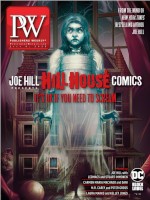Isaac Fitzgerald—a former BuzzFeed books editor, cofounder of The Rumpus, and author of two adult books about tattoos—says that his first picture book, How to Be a Pirate (Bloomsbury), was a long time in the making. “I have all of these tattoos, and one of my friend’s daughters would call me ‘the stamped man.’ ” He says his first thought was to write a picture book that explains tattoos to children, but, though tattoos remain a central part of the book, Fitzgerald credits authors and booksellers with teaching him how to transform his idea into a story that resonates with children.
When Fitzgerald moved to New York City in 2013, he discovered that his neighbor was children’s author Jon Scieszka. The two became friends, and a year later Fitzgerald nervously pitched Scieszka his idea for a children’s book explaining tattoos. To Fitzgerald’s chagrin, Scieszka responded, “That’s not a kids’ book idea.” But he offered to help.
Over a series of weeks, Fitzgerald and Scieszka met every Friday. The first week “was like a Karate Kid situation,” Fitzgerald says. Scieszka pulled his entire children’s book library off his shelves and stacked books all over the floor and the furniture. “I’m going to be in the backyard drinking rosé,” he said. “Come get me when you’re done reading all of these.”
Through his exploration of children’s literature and discussions with Scieszka about what makes a good picture book, Fitzgerald says that he was able to transform his original concept from an adult’s idea of what a kids’ book should be to a story with kid appeal.
In How to Be a Pirate, a girl named CeCe (after Fitzgerald’s niece) is told by the boys in her neighborhood that she can’t play pirates. Disappointed, she asks her tattooed grandfather for help. He advises her—”Be brave!” “Be quick!” “Be independent!” and “Fun!”—all inspired by his tattoos. The tattoos are traditional designs with roots in sailing history: the ship, the panther, the dancing lady, and the eagle.
Collaborating with artist Brigette Barrager further transformed the story. Fitzgerald says it was important to him that the family in the book be unconventional, and he had a very specific image of CeCe’s grandfather in mind: “a round, buttoned-up man with a big, bushy mustache and a tweed jacket.”
When Fitzgerald received Barrager’s initial sketches, the character took on new life. In an attached letter, she explained that she had modeled CeCe’s grandfather after her own father, who had recently passed away. She noted that her father had worked on oil rigs and sported tattoos, and that, when she had children of her own, How to Be a Pirate would be a way for them to connect with their grandfather.
“I think it shows that, for both of us, this book was a real labor of love,” Fitzgerald says. “This book isn’t actually about pirates, and it isn’t even really about tattoos; it’s about how spending time with someone you care about and telling stories can brighten your outlook on the entire world, and how it can turn a faded day into a brighter day.”
Fitzgerald is currently working on two other books for Bloomsbury. He hopes that Dirtbag, Massachusetts, an essay collection for adults, “shows young men that there are many ways to live.” He’s also writing his first young adult novel, which is based on an essay he wrote about “mental health, body image, and growing up in a low-income rural area in a family with a lot of issues and not a lot of money.”
Isaac Fitzgerald will give the keynote address 5–5:30 p.m., July 15.



 Volume 267
Issue 27
07/06/2020
Volume 267
Issue 27
07/06/2020





